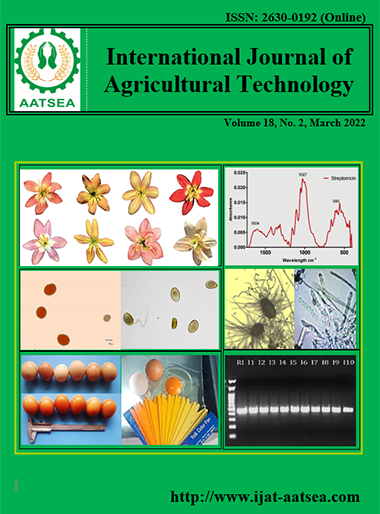Potential use of extracts and active constituent from Desmodium sequax to control fungal plant diseases
Main Article Content
Abstract
The methanol extract of the whole plant of Desmodium sequax was found to suppress efficiently fungal plant diseases. Especially, it remarkably controlled rice blast (RCB), tomato grey mold (TGM), and red pepper anthracnose (PAN) in vivo. Out of separated fractions, Hex-soluble fraction showed potent control values against RCB (93.75%), TGM (87.5%), wheat leaf rust (WLR) (80%) and PAN (95%) at 3000 µg/mL, respectively. Through bioassay-guided fractionation, compound 1 was isolated from the Hex-soluble fraction and this compound was identified as lupeol on the basis of NMR and ESI-MS data analysis. The in vivo and in vitro antifungal activity of 1 was evaluated against various fungal phytopathogens. Lupeol displayed a moderate inhibition against the mycelial growths of Rhizoctonia solani, Colletotrichum orbiculare, and Magnaporthe oryzae in vitro. Besides, in vivo antifungal efficacy of 1 against TGM and tomato late blight (TLB) over the concentration range of 125–500 µg/mL was described for the first time. The content of lupeol (2.94%) in Hex-soluble fraction was quantified by HPLC analysis. Our study demonstrated that D. sequax is a promising plant resource, contains lupeol as an antifungal constituent, and could be used to control fungal plant pathogens.
Article Details

This work is licensed under a Creative Commons Attribution-NonCommercial-NoDerivatives 4.0 International License.
References
Bae, S., Han, J. W., Dang, Q. L., Kim, H. and Choi, G. J. (2021). Plant disease control efficacy of Platycladus orientalis and tts antifungal compounds. Plants, 10:1496.
Han, J. W., Shim, S. H., Jang, K. S., Choi, Y. H., Dang, Q. L., Kim, H. and Choi, G. J. (2018). In vivo assessment of plant extracts for control of plant diseases: A sesquiterpene ketolactone isolated from Curcuma zedoaria suppresses wheat leaf rust. Journal of Environmental Science and Health, Part B, 53:135-140.
Lall, N., Weiganand, O., Hussein, A. and Meyer, J. (2006). Antifungal activity of naphthoquinones and triterpenes isolated from the root bark of Euclea natalensis. South African Journal of Botany, 72:579-583.
Lanzotti, V., Romano, A., Lanzuise, S., Bonanomi, G. and Scala, F. (2012a). Antifungal saponins from bulbs of white onion, Allium cepa L. Phytochemistry, 74:133-139.
Lanzotti, V., Barile, E., Antignani, V., Bonanomi, G. and Scala, F. (2012b). Antifungal saponins from bulbs of garlic, Allium sativum L. var. Voghiera. Phytochemistry, 78: 126-134.
Ma, X., Zheng, C., Hu, C., Rahman, K. and Qin L. (2011). The genus Desmodium (Fabaceae)-Traditional uses in Chinese medicine, phytochemistry and pharmacology. Journal of Ethnopharmacology, 138:314-332.
Muhammad, N., Sajid, A., Muhammad, Q., Syed, N. G., Inamullah, K. and Growhar, A. (2013). Antifungal activity of bioactive constituents and bark extracts of Rhododendron arboreum. Bangladesh Journal of Pharmacology, 8:218-222.
Pham, D. Q., Han, J. W., Dao, N. T., Kim, J. C., Pham, H. T., Nguyen, T. H., Nguyen, N. T., Choi, G. J., Vu, H. D. and Le Dang, Q. (2020). In vitro and in vivo antimicrobial potential against various phytopathogens and chemical constituents of the aerial part of Rumex chinensis Campd. South African Journal of Botany, 133:73-82.
Pham, T. N., Tran, T. P. T., Tran, V. L., Nguyen, T. D., Do, X. C. and Tran, V. S. (2017). Chemical constituents of ethyl acetate extract of Lepisanthes rubiginosa collected in Phu Loc district, Thua Thien - Hue province. Vietnam Journal of Chemistry, 55:1-5.
Song, J., Soytong, K., Kanokmedhakul, S., Kanokmedhakul, K. and Poeaim, S. (2020). Antifungal activity of microbial nanoparticles derived from Chaetomium spp. against Magnaporthe oryzae causing rice blast. Plant Protection Science, 56:180-190.
Tan, T. N., Trung, H. T., Le Dang, Q., Thi, H. V., Vu, H. D., Ngoc, T. N., Do, H. T., Nguyen, T. H., Quang, D. N. and Tran Dinh, T. (2021). Characterization and antifungal activity of limonoid constituents isolated from Meliaceae plants Melia dubia, Aphanamixis polystachya, and Swietenia macrophylla against plant pathogenic fungi in vitro. Journal of Chemistry 2021, e4153790.
Tsai, J. C., Huang, G. J., Chiu, T. H., Huang, S. S., Huang, S. C., Huang, T. H., Lai, S. C. and Lee, C. Y. (2011). Antioxidant activities of phenolic components from various plants of Desmodium species. African Journal of Pharmacy and Pharmacology, 5:468-476.
Teshima, Y., Ikeda, T., Imada, K., Sasaki, K., El-Sayed, M. A., Shigyo, M., Tanaka, S. and Ito, S. (2013). Identification and biological activity of antifungal saponins from Shallot (Allium cepa L. Aggregatum Group). Journal of Agricultural and Food Chemistry, 61:7440-7445.
Zeba, N. S. and Asif, Z. (1998). Chemical constituent of Desmodium sequax. Indian Journal of Chemistry, 37:1081-1082.


